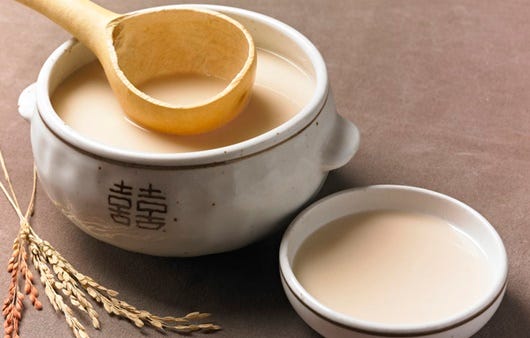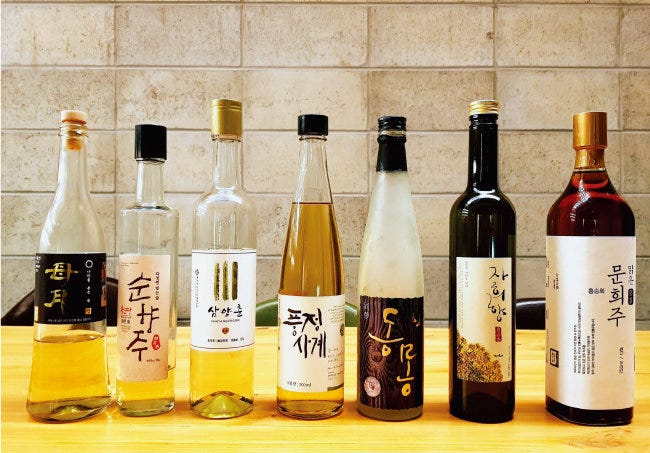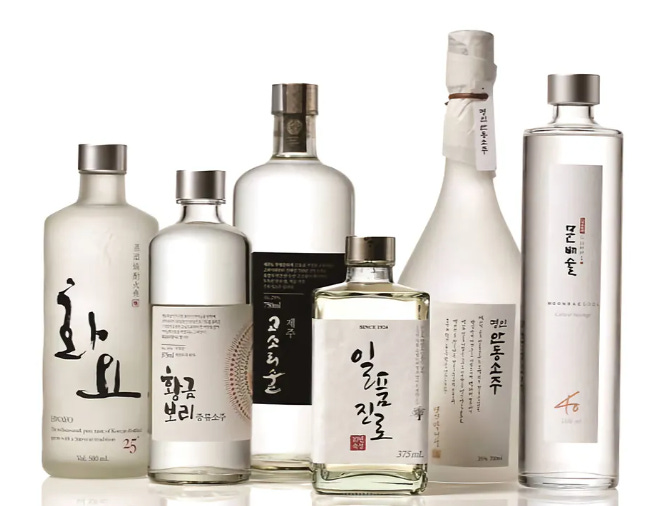I’ll be honest—this is not a subject I have a lot of confidence in writing about, despite the fact that I come from a long line of drinkers. Although my grandfather almost never drank, drinking stories of my dad with his cousins (= my uncles) when he was in his 20s are legendary. Two of my mom’s three brothers lost their lives because of heavy drinking, and my younger brother, who lives in Seoul, apparently drinks almost every night, according to my mom who’s been splitting her time between Los Angeles and Seoul the past few years.
With that said, I’m going to tackle the subject of Korean sool today.
sool (술) = alcoholic beverage
I don’t like the word “liquor” when I’m referring to traditional Korean alcoholic beverage. Think about it. The Japanese sake1 that you know of. Nobody calls it the Japanese liquor, right? Nor do people use the term the “Chinese liquor” when you’re ordering bai-jiu at Chinese restaurants.

First, the word sool itself. It is a pure Korean word = no corresponding Chinese character, and it refers to all types of alcoholic beverages—soju, beer, wine, whisky, tequila and etc. I’ll focus solely on 전통주 in this post.
전통 (jeon-tong) = traditional
주 (ju) = alcoholic beverage, liquor
** only for the purpose of this post, I’m going to refer to 전통주 as “JTJ” to make it easier for me to type. BTW, the “jiu” of Chinese bai-jiu, the “shu” of Nihon-shu (sake) and the “ju” of jeon-tong ju are all same Chinese character, 酒, meaning “sool.”
The oldest record of alcohol usage in Korea goes back at least 3000 years, about 9th century BCE. Sool has been with us for a very long time indeed.
If we’re talking about the different types of Korean JTJ, I don’t think there’re enough data centers in the world to store all that information. Almost every major household had their own recipes in cultivating 누룩 (noo-rook, “yeast”) and fermenting grain/water/noo-rook mixture to produce alcohol.
The most basic method of making Korean JTJ goes something like this. It’s not all that difficult to make—you just need a few things and the right environment. I’ve never tried making it myself (I’m not into sool, you know…), a lot of people do at home.
First, you cook regular white rice (can be sweet rice) as you normally would. Cool it to room temperature in open air, add equal amount of water and proper portion of noo-rook and mix with hand to make a wet paste. Place the mixture in a clean container (preferably an ong-gi) and let it ferment covered under a blanket in a warm setting (about 80 degrees Fahrenheit). During the fermentation process, you can actually hear the bubbles inside the container forming and popping. After 5 to 7 days, filter through a fine-mesh sieve. The liquid you have is the most rudimentary form of a Korean JTJ called…
tak-ju (탁주)
Quite literally, the word means “cloudy” sool. There were many different kinds in this category, even one that has the consistency of a thick yogurt, but basically only one kind survives today—막걸리 (makgeolli), the process by which it is made was described in the previous paragraph.
You can see why they call it the “cloudy” sool—it has milky color and texture. There are at least hundreds of different brands and types of makgeolli in Korea. Many of them infuse local grains (other than rice) and fruits to produce regionally unique makgeollis. For example, Jejudo has citrus fruit makgeolli, Gapyeong has pine nut makgeolli (가평 잣막걸리), and Gongju has chestnut makgeolli (공주 밤막걸리).

Because the yield of makgeolli (or tak-ju) is high relative to the amount of ingredients used, they are usually the cheapest. The mass-produced ones in market aisles are only about $1~$2 per bottle (in Korea). Even the premium ones are around $5 to $10 in USD (again, in Korea). For this reason, makgeolli was the alcoholic beverage of choice for common folks for more than a millennium (you’ve all seen people drinking this thing in historical K-dramas).
Makgeolli doesn’t travel well, especially the premium ones. That’s why you only see the factory produced inexpensive ones in supermarkets in Los Angeles.
Makgeolli is usually 5~6% alcohol by volume and easy to drink—slightly sweet and many of them fizzy too. It goes very well with all types of jeon (전), boiled meat (especially pork) and kimchi, and dooboo (두부, “tofu”) dishes.
Cheong-ju (청주)
Cheong-ju means “clear” sool. As the name suggests, these are of clear liquid. Depending on what other minor ingredients are added, they can take on translucent colors also. When Koreans speak of “전통주,” this is the type of sool we’re referring to the most.
I’m sure it’s a little more complicated and refined than this, but the basic principle is that makgeolli is left undisturbed in cool room temperature to separate itself—sediments of the white milky stuff will eventually precipitate to the bottom. The clear liquid at the top is cheong-ju.
These are usually around 13 to 16% in alcohol and the method by which it is made is essentially as same as the Japanese sake (= Nihon-shu).
I feel like I have to point this out at this juncture. The Korean JTJ (cheong-ju) almost went out of existence despite its long and flourishing history due to a number of external factors that happened from the late 18th to early 20th century, one of them being the Korean version of a prolonged Prohibition Act. And the art of JTJ making was largely lost while the Japanese sake industry took off and became a cultural force of its own. Bad and myopic policies will have long lasting and devastating consequences.
Anyway, in the most welcome news, cheong-ju has been making quite a comeback. Local master brewers have been trying to bring back lost recipes and technique and many of them have been succeeding. Also, new bar-restaurants that only serve regional specialty cheong-ju’s from all corners of Korea have been popping up in Seoul—not that they’re on the top of my list of places to visit.

Unlike makgeolli, cheong-ju was always the noble class’s drink (because yield is low and thus expensive) and is consumed in much smaller vessels. You’ve all seen something like this in K-dramas. On the left is a commoner drinking makgeolli in a bowl and on the right is a royalty (King, in this particular case) probably having cheong-ju in a much smaller cup. So, next time you’re watching a history-based K-drama, you can tell what kind of sool they’re having just by looking at the drinking vessel they’re holding.
All kinds of Korean, Chinese, and Japanese food, especially of the (raw) fish type, go really well with premium cheong-ju—so I’m told. Not only that, but Korean chefs have also been pairing high-end cheong-ju with certain French and Italian dishes, and with cheese plates.
Spirits (증류주)
Taking one step further, JTJ would be put under heat to go through evaporating process to increase alcohol content. This “distilled (= evaporated)” portion becomes what are known as “spirits.” The most well-known type of spirit would be the whisky, but the best-selling spirit in the world is the Korean soju.
But of course there are different types of soju. Traditionally distilled ones vs. chemically processed ones. The soju that are easily found in supermarkets for around $2 per bottle are the chemically processed ones but the premium distilled soju (10~20 times more expensive) have been gaining fandom from aficionados.
I almost forgot one of the most important things about JTJ (and this applies to Japanese sake as well). These are not supposed to be aged. They’re meant to be drunk “fresh,” preferably within the year of production. The word makgeolli itself even says so.
막 (mak): just now
걸리 (geolli): conjugated form of 거르다 which means “to filter through”
Koreans can drink with the best of them. The quantity was always there and now the quality is catching up.
The correct term is actually Nihon-shu.














Fascinating post. They have a couple of great cocktail scenes in First Night with the Duke. I'm going to have some makgeolli with drops of black raspberry wine (bokbunjajoo?) that I saw in the show.
Thank you for the insight. I started watched modern day K-drama last year. This year I started watching historical ones, I was always interested to learn more about this infamous drink from Korea.